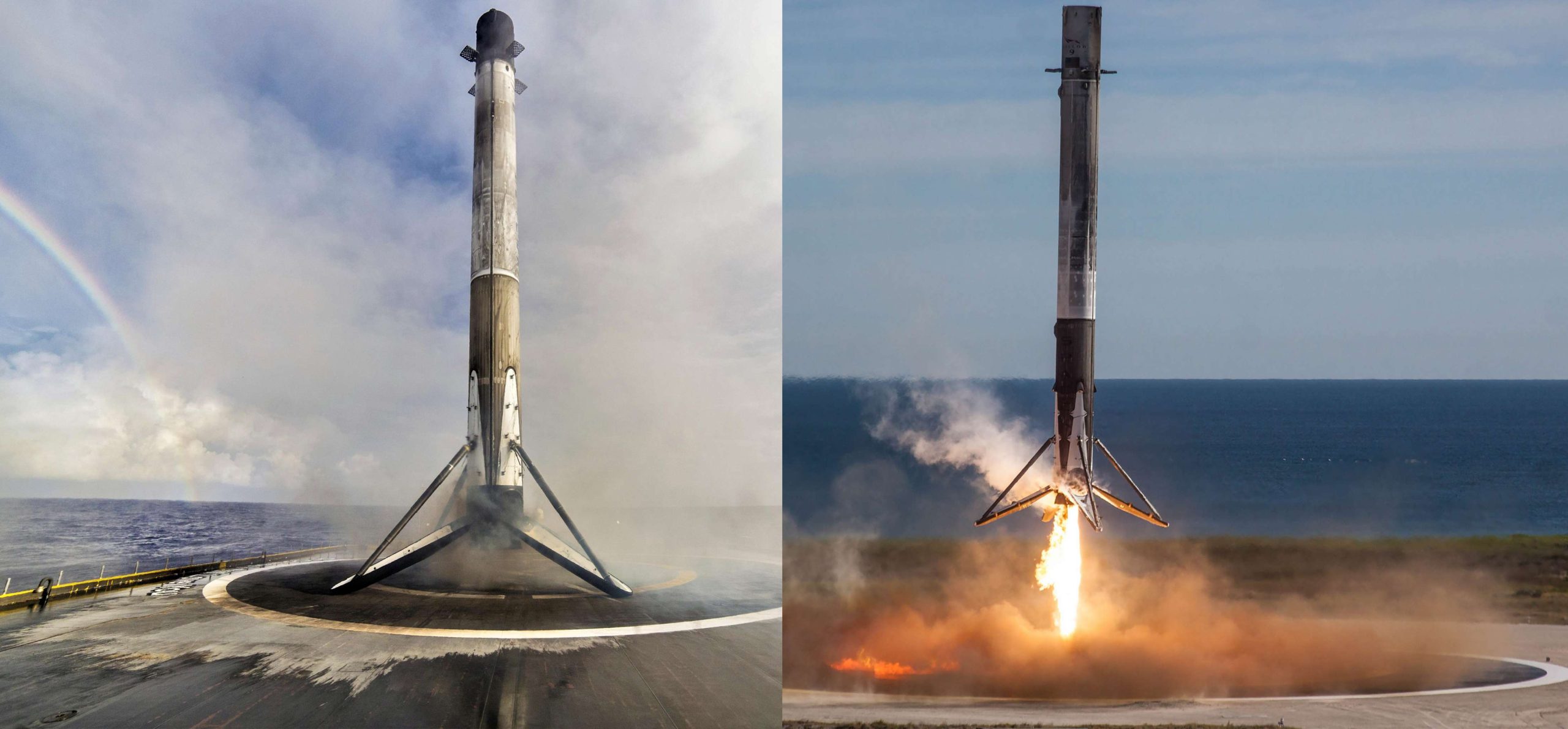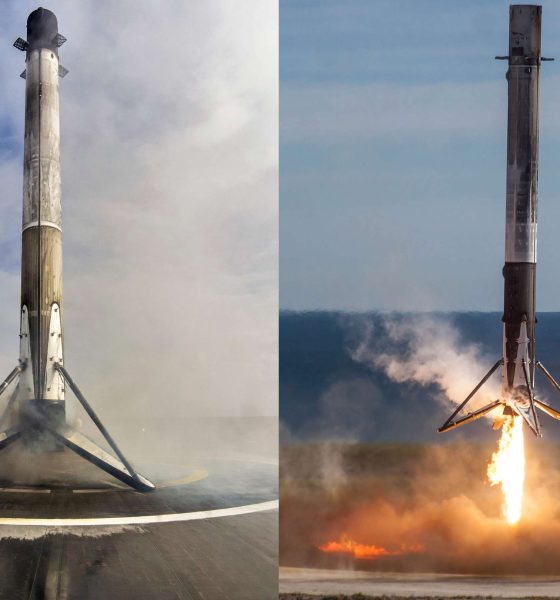

News
SpaceX shifts Falcon 9 booster from landing pad to drone ship after anomaly
SpaceX officially confirmed that it will move the location of a Falcon 9 booster’s post-launch recovery in order to better preserve the site of Crew Dragon’s catastrophic April 20th failure.
Instead of returning the booster to one of SpaceX’s two Cape Canaveral Landing Zones (LZs), SpaceX has applied for an FCC permit to land the rocket less than 20 miles (~30 km) off the coast of Florida on the drone ship Of Course I Still Love You (OCISLY). The culprit for the last-second change of plans is a catastrophic failure of Crew Dragon that spread debris throughout SpaceX’s Landing Zone facilities, debris that will now be critical for the process of anomaly resolution. Landing a Falcon 9 booster at LZ-1 or 2 would invariably spread Crew Dragon’s debris and complicate the failure investigation even further.
Much like a tornado passing through a crime scene would likely hamper the value of that crime scene and any related investigations, a Falcon 9 booster landing at the scene of a fresh accident investigation would be an extremely unwelcome complication. Even with just one Merlin 1D engine firing during a Falcon 9’s landing burn, the engine exhaust departs the nozzle traveling approximately 2.7 km/s (1.7 mi/s) and could easily send Crew Dragon remnants hundreds or even thousands of feet away and incinerate smaller debris. Given that Crew Dragon’s explosion appears to have been highly energetic, many, many pieces will already be spread many hundreds – and perhaps thousands – of feet around the incident.
Crew Dragon is an extremely complex spacecraft. Even the tiniest of fragments could potentially be critical to the successful completion of the explosion investigation, especially if the fault began somewhere in capsule C201’s many hundreds of feet of plumbing. The pipes, valves, and pumps that make up Crew Dragon’s propellant management system have many hundreds (if not thousands) of small parts that must work without issue to safely pressurize and handle the spacecraft’s hypergolic propellant.


Cargo Dragon set for launch
Despite Crew Dragon’s serious failure and the need to change Falcon 9’s booster recovery plans at the last moment, SpaceX still appears to be working to maintain the planned launch date. The instantaneous window is set for 4:22 am ET (08:22 UTC), April 30th, delayed five days from the original April 25th target. Based on an update provided by NASA last week, those delays are the result of International Space Station (ISS) scheduling and additional time needed for payload preparations. Orbital-ATK’s (now “Northrop Grumman Innovation Systems” or NGIS) uncrewed Cygnus spacecraft successfully berthed with the ISS on April 19th, followed by the station’s astronauts unloading the three metric tons of cargo it contained over the next several days.
Once Cygnus operations have been completed, the ISS astronauts will be able to start preparing for Cargo Dragon’s CRS-17 resupply mission, likely carrying another three or four metric tons of pressurized cargo. Although the logistics of unloading, unpacking, and stowing the contents of hundreds of packages of consumables, hardware, tools, science experiments, and more is not exactly thrilling, the reality is that the task takes a surprising amount of time and care. Of the maximum six astronauts aboard the ISS at any given moment, only a few of them are able to focus exclusively on the cargo logistics at the same time as time-sensitive science experiments must be immediately set up to avoid ruining the data produced. Furthermore, although the ISS is truly massive, there are only a handful of berthing and docking ports and the actual habitable volume can be cramped, as are the ports between the station and visiting spacecraft.
An unknown Falcon 9 booster – perhaps B1056 – will perform a routine static fire test at SpaceX Launch Complex 40 (LC-40) five or so days before launch, likely within the next 48 hours. Soon after, Falcon 9 will be mated with CRS-17’s flight-proven Cargo Dragon capsule and expendable trunk before rolling back out to LC-40. If the FCC works fast and grants SpaceX’s updated booster recovery license in the next few days, CRS-17 should remain on track for an April 30th launch.
Check out Teslarati’s Marketplace! We offer Tesla accessories, including for the Tesla Cybertruck and Tesla Model 3.

Elon Musk
Elon Musk’s X will start using a Tesla-like software update strategy
The initiative seems designed to accelerate updates to the social media platform, while maintaining maximum transparency.

Elon Musk’s social media platform X will adopt a Tesla-esque approach to software updates for its algorithm.
The initiative seems designed to accelerate updates to the social media platform, while maintaining maximum transparency.
X’s updates to its updates
As per Musk in a post on X, the social media company will be making a new algorithm to determine what organic and advertising posts are recommended to users. These updates would then be repeated every four weeks.
“We will make the new 𝕏 algorithm, including all code used to determine what organic and advertising posts are recommended to users, open source in 7 days. This will be repeated every 4 weeks, with comprehensive developer notes, to help you understand what changed,” Musk wrote in his post.
The initiative somewhat mirrors Tesla’s over-the-air update model, where vehicle software is regularly refined and pushed to users with detailed release notes. This should allow users to better understand the details of X’s every update and foster a healthy feedback loop for the social media platform.
xAI and X
X, formerly Twitter, has been acquired by Elon Musk’s artificial intelligence startup, xAI last year. Since then, xAI has seen a rapid rise in valuation. Following the company’s the company’s upsized $20 billion Series E funding round, estimates now suggest that xAI is worth tens about $230 to $235 billion. That’s several times larger than Tesla when Elon Musk received his controversial 2018 CEO Performance Award.
As per xAI, the Series E funding round attracted a diverse group of investors, including Valor Equity Partners, Stepstone Group, Fidelity Management & Research Company, Qatar Investment Authority, MGX, and Baron Capital Group, among others. Strategic partners NVIDIA and Cisco Investments also continued support for building the world’s largest GPU clusters.
News
Tesla FSD Supervised wins MotorTrend’s Best Driver Assistance Award
The decision marks a notable reversal for the publication from prior years, with judges citing major real-world improvements that pushed Tesla’s latest FSD software ahead of every competing ADAS system.

Tesla’s Full Self-Driving (Supervised) system has been named the best driver-assistance technology on the market, earning top honors at the 2026 MotorTrend Best Tech Awards.
The decision marks a notable reversal for the publication from prior years, with judges citing major real-world improvements that pushed Tesla’s latest FSD software ahead of every competing ADAS system. And it wasn’t even close.
MotorTrend reverses course
MotorTrend awarded Tesla FSD (Supervised) its 2026 Best Tech Driver Assistance title after extensive testing of the latest v14 software. The publication acknowledged that it had previously criticized earlier versions of FSD for erratic behavior and near-miss incidents, ultimately favoring rivals such as GM’s Super Cruise in earlier evaluations.
According to MotorTrend, the newest iteration of FSD resolved many of those shortcomings. Testers said v14 showed far smoother behavior in complex urban scenarios, including unprotected left turns, traffic circles, emergency vehicles, and dense city streets. While the system still requires constant driver supervision, judges concluded that no other advanced driver-assistance system currently matches its breadth of capability.
Unlike rival systems that rely on combinations of cameras, radar, lidar, and mapped highways, Tesla’s FSD operates using a camera-only approach and is capable of driving on city streets, rural roads, and freeways. MotorTrend stated that pure utility, the ability to handle nearly all road types, ultimately separated FSD from competitors like Ford BlueCruise, GM Super Cruise, and BMW’s Highway Assistant.
High cost and high capability
MotorTrend also addressed FSD’s pricing, which remains significantly higher than rival systems. Tesla currently charges $8,000 for a one-time purchase or $99 per month for a subscription, compared with far lower upfront and subscription costs from other automakers. The publication noted that the premium is justified given FSD’s unmatched scope and continuous software evolution.
Safety remained a central focus of the evaluation. While testers reported collision-free operation over thousands of miles, they noted ongoing concerns around FSD’s configurable driving modes, including options that allow aggressive driving and speeds beyond posted limits. MotorTrend emphasized that, like all Level 2 systems, FSD still depends on a fully attentive human driver at all times.
Despite those caveats, the publication concluded that Tesla’s rapid software progress fundamentally reshaped the competitive landscape. For drivers seeking the most capable hands-on driver-assistance system available today, MotorTrend concluded Tesla FSD (Supervised) now stands alone at the top.
News
Elon Musk’s Grokipedia surges to 5.6M articles, almost 79% of English Wikipedia
The explosive growth marks a major milestone for the AI-powered online encyclopedia, which was launched by Elon Musk’s xAI just months ago.

Elon Musk’s Grokipedia has grown to an impressive 5,615,201 articles as of today, closing in on 79% of the English Wikipedia’s current total of 7,119,376 articles.
The explosive growth marks a major milestone for the AI-powered online encyclopedia, which was launched by Elon Musk’s xAI just months ago. Needless to say, it would only be a matter of time before Grokipedia exceeds English Wikipedia in sheer volume.
Grokipedia’s rapid growth
xAI’s vision for Grokipedia emphasizes neutrality, while Grok’s reasoning capabilities allow for fast drafting and fact-checking. When Elon Musk announced the initiative in late September 2025, he noted that Grokipedia would be an improvement to Wikipedia because it would be designed to avoid bias.
At the time, Musk noted that Grokipedia “is a necessary step towards the xAI goal of understanding the Universe.”
Grokipedia was launched in late October, and while xAI was careful to list it only as Version 0.1 at the time, the online encyclopedia immediately earned praise. Wikipedia co-founder Larry Sanger highlighted the project’s innovative approach, noting how it leverages AI to fill knowledge gaps and enable rapid updates. Netizens also observed how Grokipedia tends to present articles in a more objective manner compared to Wikipedia, which is edited by humans.
Elon Musk’s ambitious plans
With 5,615,201 total articles, Grokipedia has now grown to almost 79% of English Wikipedia’s article base. This is incredibly quick, though Grokipedia remains text-only for now. xAI, for its part, has now updated the online encyclopedia’s iteration to v0.2.
Elon Musk has shared bold ideas for Grokipedia, including sending a record of the entire knowledge base to space as part of xAI’s mission to preserve and expand human understanding. At some point, Musk stated that Grokipedia will be renamed to Encyclopedia Galactica, and it will be sent to the cosmos.
“When Grokipedia is good enough (long way to go), we will change the name to Encyclopedia Galactica. It will be an open source distillation of all knowledge, including audio, images and video. Join xAI to help build the sci-fi version of the Library of Alexandria!” Musk wrote, adding in a later post that “Copies will be etched in stone and sent to the Moon, Mars and beyond. This time, it will not be lost.”








